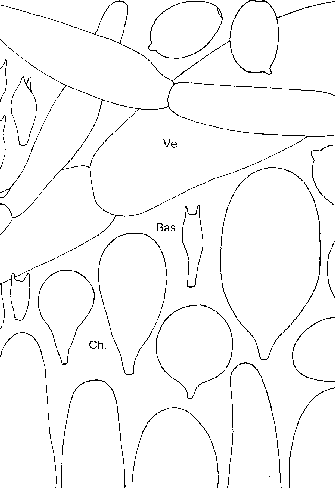Macroscopic features |
Pileus 5-20 x 3-14 mm when still closed, expanded up to 35 mm in diam., first grey to grey-brown, later at centre becoming pale and greyish or yellowish grey-brown. Lamellae (number not noted) very crowded, white to dark grey-brown, finally black. Stipe up to 100 x 2-5 mm, white, hollow, hairy floccose, especially in lower part, and slightly broadening towards somewhat bulbous base. |
Microscopic features |
Spores [160,8,7] (9.0-)9.7-14.0(-16.3) x 7.1-9.8(-10.4) µm; Q = 1.25-1.60, av. Q = 1.30-1.50; av. L = 10.6-13.3, av. B = 8.1-9.1 µm, broadly ellipsoid or ovoid with rounded base and apex, medium to dark red-brown, and central, c. 1.3 µm wide germ pore. Basidia 14-38 x 7-10 µm, 2-spored, surrounded by (3-)4-5(-6) pseudoparaphyses. Pleurocystidia 70-110 x 26-37 µm, elongate ellipsoid, ellipsoid or (sub)cylindric. Cheilocystidia 35-75 x 17-38 µm, (sub)globose, ellipsoid, ovoid, broadly subcylindric or slightly utriform. Veil made up of cylindrical, often inflate or fusoid elements, 40-280 x 4-40(-70) µm. Clamp-connections present. |
Habitat & distribution |
Growing subfasciculate on sawdust and compost. Very rare. In the Netherlands only known from greenhouses. |
Remarks |
The 2-spored basidia, hyphoid veil and its habitat on sawdust or compost make Coprinus scobicola easily to recognize. The only other species in subsect. Lanatuli with two-spored basidia, C. bicornis, differs by having a mixed veil with ellipsoid to subglobose elements, much smaller basidiocarps and growth on dung. |

[Copyright © by ]